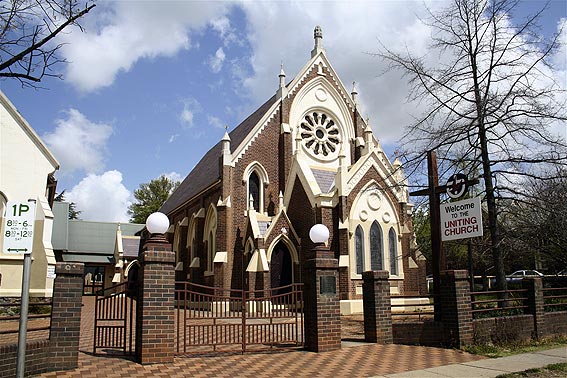
Wesley Uniting Church, Armidale
[Photograph by Trevor Bunning (September 2007)]

Wesley Uniting Church, Armidale
[Photograph by Trevor Bunning (September 2007)]
Historical and Technical Documentation by Kelvin Hastie and Pastór de Lasala
© OHTA 1998, 2014 (last updated April 2014)
The first Wesleyan service was held in the Armidale Court House in 1859. It was not until 1864 that the first Methodist church was built. Twenty-nine years later the present church was opened by The Revd George Lane.1
Of the small number of organs that the English firm of Henry Willis & Sons exported to N.S.W, only five remain essentially unaltered. The organ that can be found today in the Wesley Church, Armidale was originally purchased for the first St Stephen's Presbyterian Church located in Phillip Street, Sydney. It was installed in the rear gallery of the church by the Sydney organbuilder Charles Jackson during December 1879 and January 1880. The dedication took place on 24 January 1880.2
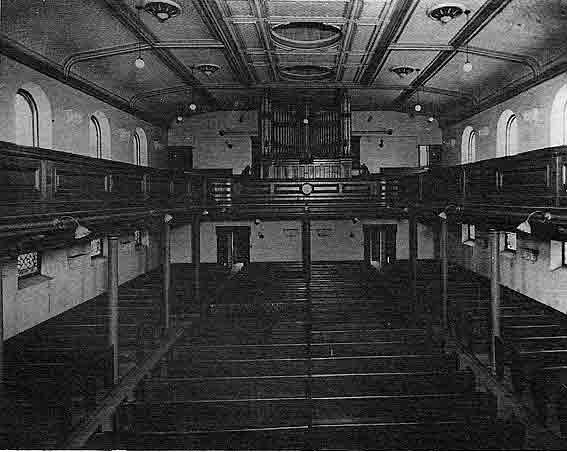
The 1879 Willis organ in the former
St Stephen's Prebyterian Church, Phillip Street, Sydney
[Photograph from St Stephen's church display]
When the congregation moved in 1934 to the present St Stephen's Church in Macquarie Street, a new three-manual Hill, Norman & Beard organ had been built for it. The redundant Willis was advertised for sale and in 1935 it was purchased by Wesley Church for £1,000. The instrument was erected by Hill, Norman & Beard in the centre of the church at the northern end. The action on the pedal division was changed from tracker to pneumatic at this time. The organ was dedicated on Sunday 21 July 1935, and was described as follows:
The instrument, which has a particularly mellow tone, is a two-manual organ of the tracker action type, and was purchased from St. Stephen's Church in Sydney. It is finished in polished cedar and the pipes are gilded, giving it a very handsome appearance.3

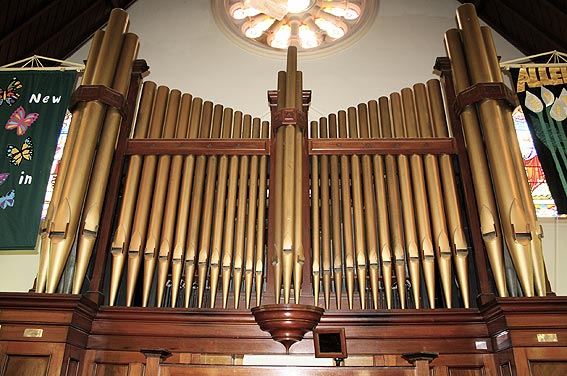
The 1879 Willis organ at Wesley Uniting Church, Armidale
[Photographs by Trevor Bunning (September 2007)]
By the late 1960s it had become apparent that major repairs were needed. At that time Mr Tom Brown, a former student of Dr George Faunce Allman, was organist. During preliminary discussions it was contemplated to make tonal changes. Fortunately these were never brought about, thus preserving the organ's original and historical character. During the late 1970s the organ was used for teaching students of the University Music Department. The action had become increasingly difficult to manipulate, thus highlighting the necessity of restoration. On 8 June 1980 the musicians of Armidale came together to launch a public appeal fund through a choral and organ concert.4
In January-March 1983 Roger H. Pogson carried out restoration work which included cleaning, repairing and revoicing the reed stops, cleaning pipes and action, repairing the entire tracker action of manuals and pedal couplers, regulation of pipework, modifying the pedal windchests, and raising the wind pressure from 2-5/8" to 3''.5 The restoration work was done in two stages, the second being completed in 1985. A heritage grant of $10,000 was awarded, the consultant being Kelvin Hastie.6
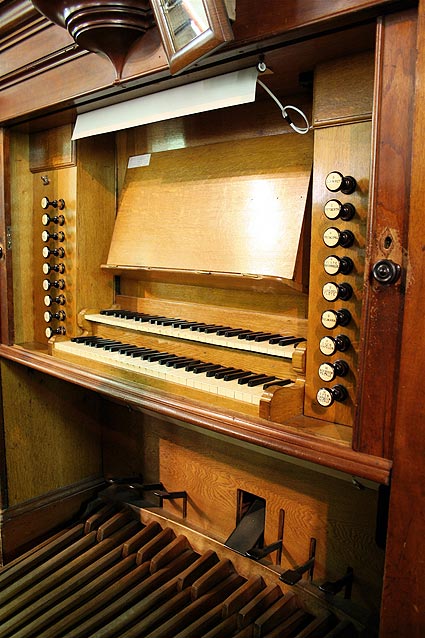
Console of the 1879 Willis organ
[Photograph by Trevor Bunning (September 2007)]
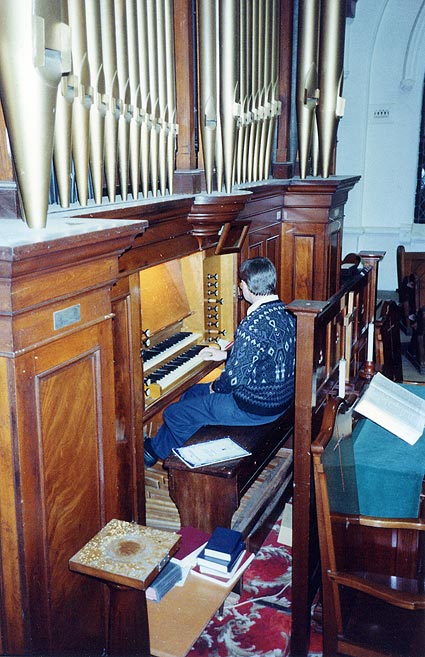
Console of the 1879 Willis organ
[Photograph by Mark Quarmby (September 1991)]
Further conservation work was carried out in 2012 by Peter D.G. Jewkes Pty Ltd of Sydney, again with Dr Kelvin Hastie as consultant. The work included a thorough cleaning and overhaul of the organ, and lowering of the wind pressure to 2 3/4" - an authentic Willis pressure for the period. Special attention was given to the reed stops by the celebrated English nineteenth-century reed specialist, Dr David Frostick.7
The specification is:
| Great Open Diapason Claribel Flute Dulciana Principal Flute Harmonique Fifteenth Clarinet Swell Open Diapason Lieblich Gedact Salcional Vox Angelica Gemshorn Cornopean Pedal Open Diapason Bourdon |
8 8 8 4 4 2 8 8 8 8 8 4 8 16 16 |
Couplers
Swell to Great
Swell to Pedals
Great to Pedals
Compass: 56/30
Mechanical action to manuals
Pneumatic action to pedals
General tremulant (by lever pedal)
3 composition pedals to Great & Pedal
3 composition pedals to Swell
Balanced swell pedal.8
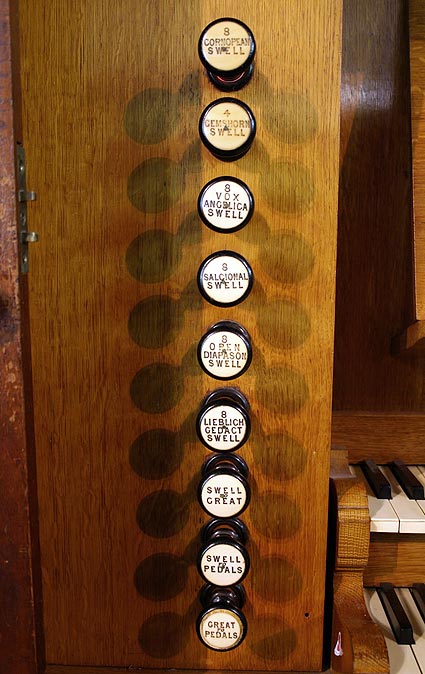
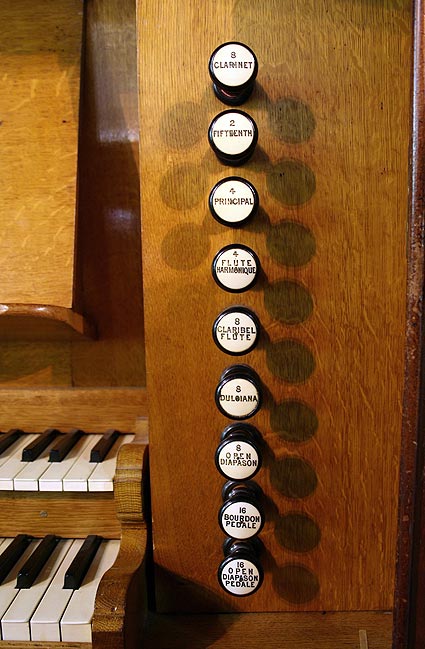
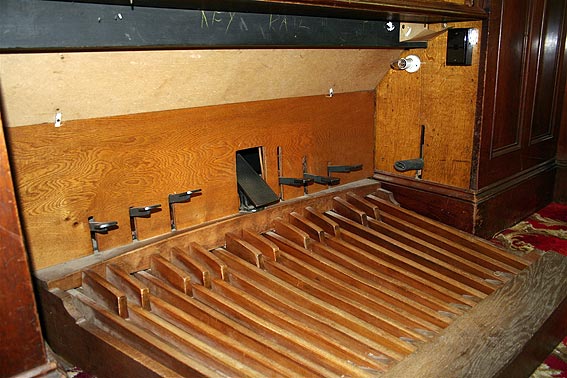
Console details of the 1879 Willis organ
[Photograph by Trevor Bunning (September 2007)]
_____________________________________________
1 Recollections (Armidale: Wesley Church, 1973).
2 Cecil Hill, 'Restorations: Wesley Uniting Church, Armidale, N.S.W,' OHTA News, vol. 8, no. 3 (July 1984), p. 17.
3 Armidale Express (22 July 1935), cited in Hill, op. cit., p. 18.
4 Hill, op. cit., p. 19.
5 Hill, op. cit., pp. 19-20.
6 Personal communication to Pastór de Lasala from Kelvin Hastie, June 1998.
7 'Off the Chest,' The Sydney Organ Journal, vol. 43, no. 3 (Winter 2012), p. 50.
8 Hill, op. cit., p. 20, and from photographs by Trevor Bunning (September 2007).
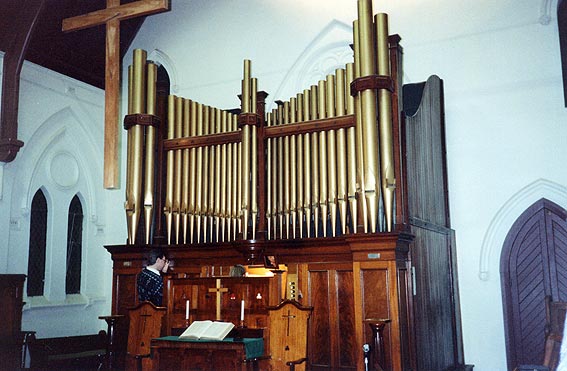
[Photograph by Mark Quarmby (September 1991)]